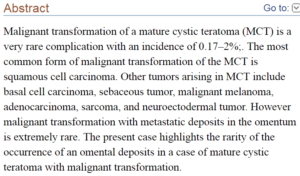
An ovarian cyst has the potential to turn into cancer. This does not apply to all types of ovarian cysts.
The question, then, is how worried should you be if you’ve been diagnosed with an ovarian cyst?
The malignant transformation of an ovarian cyst is much more likely to occur in women over 50, but can also happen in younger women.
However, 80 percent of cysts occur in premenopausal women — and this may actually be why most malignant transformations occur in postmenopausal women.
“The diagnosis of an ovarian cyst is usually made by palpating it on a pelvic exam and then confirming its presence by ultrasound,” says Karen Patrusky, a board certified OBGYN and F.A.C.O.G. in private practice for 20+ years.
“The ultrasound will not only describe its size, but also its physical characteristics, which can be very informative about whether or not it is suspicious for cancer — and thereby determine if it can be watched or whether it needs to be removed,” explains Dr. Patrusky.
What are some suspicious features?
One suspicious feature that an ultrasound can detect is if the mass has “flow,” or its own vascular network. A malignant tumor always has its own vascular supply.
Another concerning feature is if the cyst is heterogenous — meaning, not the same throughout.
“Many other factors must also be considered; age, symptoms, size of cyst, consistency on sonogram and family history,” says Dr. Patrusky.
“Most cysts in a woman who is still menstruating will resolve without any intervention, as these are typically functional cysts and are related to a woman’s cycle.
“Cysts that have solid features are less likely to resolve — but don’t always need to be removed.
“This again will depend on size, symptoms and medical and family history.
“If a woman is experiencing pain or there is concern about a torsion or a twisting, then it may be necessary to remove the cyst.
“When a cyst is rapidly growing, when it shows features that suggest a malignancy on sonogram — especially if she has symptoms — or if there is a family history, then there is need for concern.
“If this is the case, then tumor markers and further radiographic studies are performed to further understand the behavior of the mass and decide how to best treat this woman.”
Type of Ovarian Cyst that Can Turn into Cancer
It’s the dermoid cyst, also called a teratoma or mature cystic teratoma (MCT).
These benign cysts originate from germ or embryonic cells and thus contain different kinds of tissue such as cartilage, bone and skin.
Over 80 percent of MCTs develop during reproductive years. A woman may go her entire life without ever knowing she has one of these.
The discovery is made when the cyst gets big enough to cause symptoms, namely abdominal discomfort, and a woman thus undergoes a diagnostic ultrasound.
The ovarian cyst may also be discovered by accident, when a woman undergoes an ultrasound for an unrelated reason such as pregnancy.
It can also be picked up incidentally by an MRI for a totally unrelated reason, such as to investigate groin pain from exercise.
Should you lose sleep over the diagnosis of a dermoid cyst?
Studies across the board affirm that malignant transformation is rare. You need NOT panic or toss in your sleep. Relax.
Wear your seatbelt, eat healthfully, exercise, manage your weight, don’t smoke, limit drinking, get regular Pap, mammogram and colonoscopy screenings, and you may live to 100!
How rare is a cancerous transformation of this ovarian cyst?
The Journal of Case Reports Pathology (2012, Mandal et al) states:

The omentum is a membrane that connects the stomach with other organs.
To put the rarity of this cancer another way, Case Reports in Obstetrics and Gynecology (2017, Jitsumori et al) cites the following data:
• In one study (Peterson et al), the mature dermoid ovarian cysts turned into cancer in 1.8% of 8,000 patients.
• The rate was reported to be one to two percent by Hurwitz et al.
• Kim et al reported a rate of four out of 560 patients (0.6%). The cancer was discovered when these patients underwent surgery for their teratomas at Dr. Hurwitz’s facility.
As mentioned earlier, most cancer transformations of ovarian dermoid cysts happen in women over 50. But this isn’t believed to be due to a weaker, aging body.
Obstetrics & Gynecology Science (2015, Park et al) points out that most MCTs may be found 15 to 20 years prior to turning into cancer, and that “it is possible that prolonged exposure to various carcinogens in the pelvic cavity might lead to malignant transformation,” says the paper.
It may be this reason that malignant transformations usually occur in postmenopausal women.
The Jutsimori et al paper says the time span between discovery of the MCT and eventual cancer transformation is at least 10 years.
Risks of Ovarian Cyst Turning into Cancer
• HPV infection
• Elevated CA-125
• Older age
• Large cysts
Because there’s a big time lag between when these ovarian cysts turn into cancer, it’s recommended that women, who’ve already been diagnosed with a dermoid type, undergo continuous surveillance and be informed of the possibility of malignant transformation – even though it is rare.
Dr. Patrusky is the developer of Voila Intimate Mood Oil, a 100% organic, non-hormonal lubricant made from coconut oil infused with the purest natural herbal oils. All five formulas are vegan, cruelty-free and U.S. produced. Voilamoodoil.com
 Lorra Garrick is a former personal trainer certified by the American Council on Exercise. At Bally Total Fitness she trained clients of all ages for fat loss, muscle building, fitness and improved health.
Lorra Garrick is a former personal trainer certified by the American Council on Exercise. At Bally Total Fitness she trained clients of all ages for fat loss, muscle building, fitness and improved health.
.








































